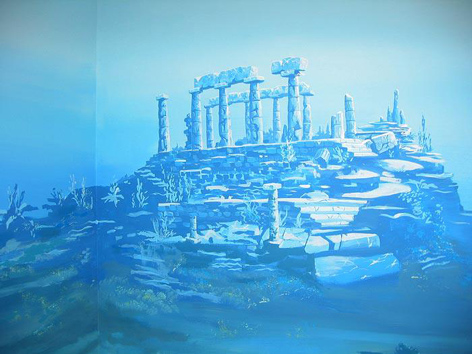| |
|
Origins |

What
Brown's Ruins in the Bahamas might once have looked like
Has
an Atlantean Temple been Discovered in the Bahamas? Andrew Collins Reports
A
new underwater archaeological site in the
Bahamas opens up the mystery once
again
London, November 01, 2012. Mysteries researchers Dr Greg Little and his wife Dr Lora Little, who for the past ten years have been investigating archaeological features in the Bahamas, have this week announced the discovery of a potential new underwater site 30 miles (50 km) south of the Bahaman Island of Bimini. It sits close to the edge of the Great Bahama Bank in 20 feet (6 m) of water, and has been named Brown's Ruins in honour of its finders Eslie and Krista Brown, professional divers from Bimini who work closely with Greg and Lora on their dive trips.
The
site is made up of thousands of stone blocks, many rectilinear in shape, others
columnar, which are spread out in a tear shape across an area estimated to be
530 feet (160 m) in length and 130 feet (40 m ) in width. The stones are regularly
8 feet by 3 feet by 2 feet (2.43 x 0.91 x 0.61 m) in size and regular weigh three
to four tonnes a piece. There are smaller blocks also like cubes, triangles and
beams. At the top of the stone strewn structure are large flat stones that give
the appearance of a raised platform, like those seen on the summits of pyramids
in Central and South America.
Blueschist
Stones at the site examined so far by two laboratories have revealed that the structure is made from a metamorphic rock called blueschist, which only forms under extremely high pressure, and yet under very low temperatures, at a depth of 22 miles (35 km) beneath the earth, before being thrust upwards by geological processes. Underwater the stone blocks at Brown's Ruins have a distinct blue-purple hue, due to the presence of the mineral glaucophane. They also contain a degree of quartz, as well as traces of opal.
Although blueshist does not occur naturally in the Bahamas, it is found in the Caribbean, with the nearest sources being the Blue Mountains of Jamaica and the mountains of central and eastern Cuba. However, no known exploitation of these natural resources can be traced. Blueschist axes known as celts have been found in Jamaica. Their makers remain unclear, although they were a Neolithic culture who inhabited the island thousands of years ago. However, these were almost certainly manufactured from lose rocks found scattered about the Blue Mountains, and were not mined from the bedrock.
Elsewhere
in the world, blueschist has been used in the past as a building material, most
notably on the Island of Crete in the Greek Aegean, where it was employed in the
construction of walls and buildings as early as, c. 1500 BC. However, the Minoans
are not known to have made transatlantic crossings; their sources of blueschist
coming from Greece and/or Turkey.
Atlantean Ruins
If Brown’s Ruins constitutes evidence of a building structure of immense proportions, the question remains - who made it and when? As the Bahamas are only officially thought to have been occupied first around 500-700 AD, no known local culture can have been responsible, especially as the site is located on a shoreline that was submerged by rising waters some 6,000 years ago (although the structure itself could be far older, even by many thousands of years).
No known cultures with sea-faring capabilities existed in the region at that time, conjuring the possibility that the structure belongs to Plato’s fabled island of Atlantis, with its vast island empire and ocean-going race, destroyed in one night and a day by earthquakes and floods sometime around 9500 BC.
The readings of American “sleeping prophet” Edgar Cayce predicted that a temple of Atlantis existed in the Bahaman waters, and that it would be found south of the island of Bimini. This is exactly where Brown’s ruins are to be found. So has Atlantis finally been found? Only time will tell.
Investigations into the origins of Brown’s Ruins continue, with top priority being the geological signature of the blueschist blocks found on the site. Did they come from Jamaica, or the interior of Cuba? The smart money would be on Cuba, where in 2001 another potential archaeological site of great importance was discovered off the island’s west coast by Canadian salvage company ADC Communications, run by Paulina Zeletski and Paul Weinsweig. Huge blocks of stone were found at a depth of 800 feet and investigated by an ROV (remote operated vehicle).
 | Artist's impression of Cuba's underwater pyramid located in deep water off the island's west coast in 2001. This 3D image was created by Dean Clarke of Atlantisite.com after he studied the deep-sea sonar image released to the world. |
In
the present author’s book Gateway to Atlantis, published in 2000, Plato’s
Atlantis was identified as Cuba, with the former Bahaman landmass, where today
there are only 1000’s of islands and cays, being the sunken lands drowned
in one night and a day by earthquakes and floods.
Greg
and Lora's Alternative
Perceptions website carries the full story of the discovery, with a brief
video showing the site.
To buy copies of GATEWAY TO ATLANTIS click here. |
